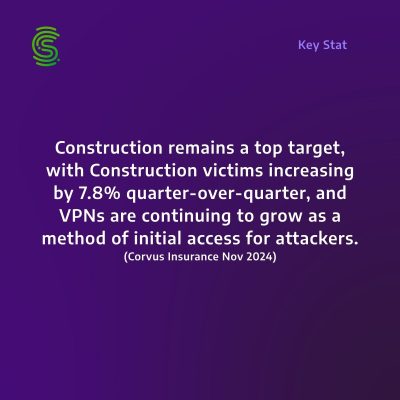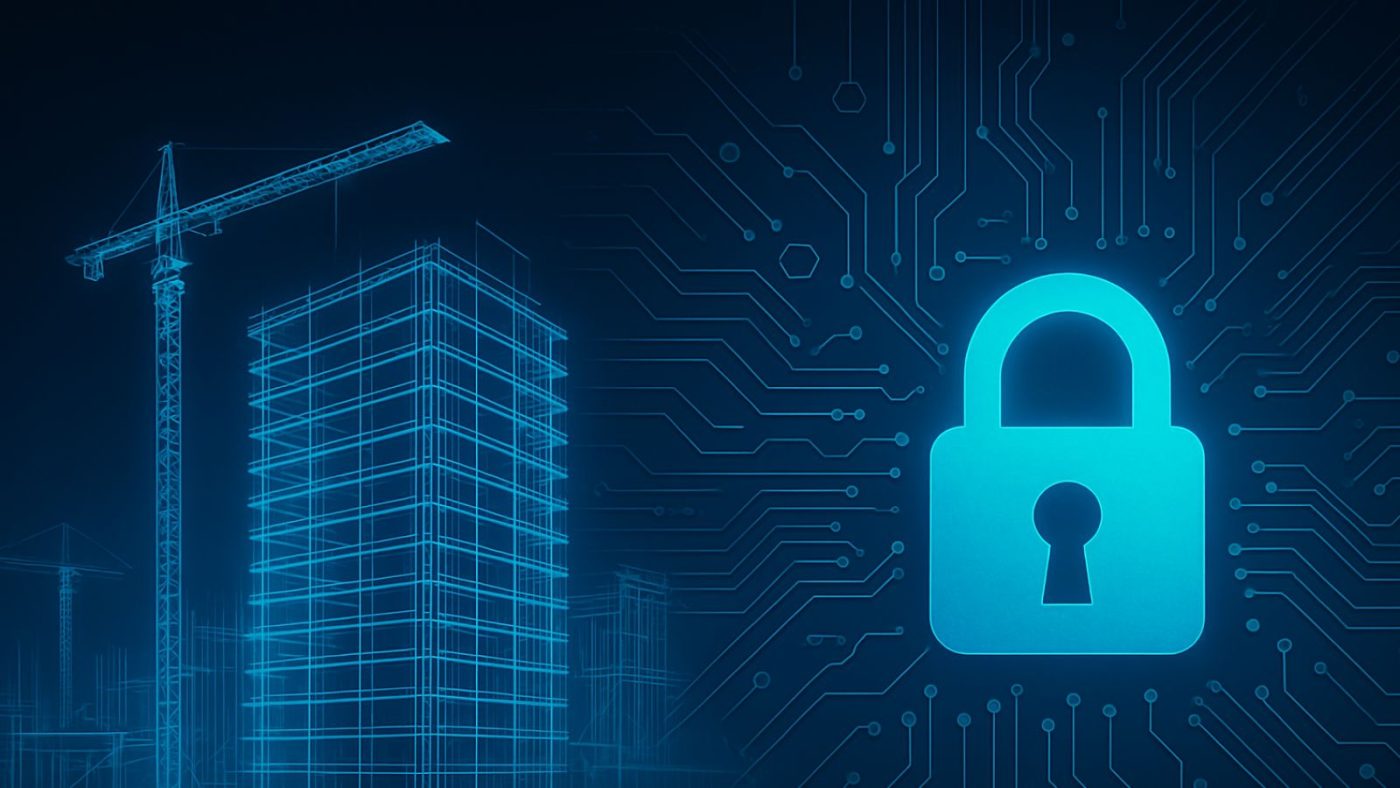Construction Goes Digital—But At What Cost?
Construction has traditionally been viewed as a physical industry—concerned with bricks, steel, and concrete. But today, it is just as much about data. The shift towards digital tools like Building Information Modelling (BIM), smart devices, and cloud-based project platforms has reshaped how buildings are designed and delivered.
This transformation brings huge benefits: better collaboration, faster decisions, and greater project accuracy. But it also opens up new risks. As systems become more connected, cybercriminals are finding fresh ways to attack construction firms.
In 2024 alone, ransomware attacks against the construction industry rose 41%, with 481 construction companies publicly listed on data-leak sites (ReliaQuest, 2024). These attacks result in project delays, lost revenue, and long-term reputational damage.
BIM: A Central Hub That Needs Protection
Building Information Modelling (BIM) plays a critical role in large-scale construction projects. It is used to coordinate plans, models, specifications, and schedules in one shared environment. It supports collaboration between architects, engineers, quantity surveyors, and subcontractors.
But its strength—centralised project information—is also its greatest vulnerability. If an attacker gains access to a BIM system, they could steal intellectual property, delay projects by corrupting files, or launch ransomware attacks to lock down vital information.
BIM platforms must be treated like critical business systems. That means applying access controls, encrypting data, ensuring software is kept up to date, and monitoring for suspicious activity. Most importantly, users should only have access to the parts of the model they genuinely need.
Cyber security is not just a technical matter here—it is part of protecting the integrity and delivery of every project.
IoT on Construction Sites: High-Tech, High-Risk
Connected devices are now standard on modern construction sites. Drones monitor progress. Sensors track environmental data. Wearables improve worker safety. These IoT devices boost efficiency, but they are often the weakest point in your security.
Many IoT devices come with default settings and basic firmware that lack proper protection. In early 2024, global cyberattacks targeting IoT devices rose by 107% (WCA, 2024). Attackers increasingly use these devices to gain entry to larger systems or form part of large-scale botnets, as seen in the Mirai malware attacks (Asimily, 2024).
Construction firms must track which devices are connected to their networks, keep firmware updated, and separate them from key business systems to reduce risk.
Smart Buildings: Physical Infrastructure Under Threat
Smart buildings use connected technology to control lighting, HVAC, elevators, and access control. While these systems improve energy efficiency and occupant comfort, they are also entry points for cybercriminals.
In one real case, a smart hotel system was compromised, locking guests out of their rooms until a ransom was paid. In another, attackers overheated a building’s smart heating system in Finland, creating a fire risk (Bleeping Computer, 2016).
As more buildings incorporate smart infrastructure, construction firms must work with clients to ensure systems are secure from day one. This includes choosing trusted technology providers, isolating OT from IT systems, and building in cyber resilience from the design stage.
Cloud, SaaS, and AI: Power Tools with Risk
Construction teams increasingly rely on Software-as-a-Service (SaaS) and cloud-based platforms to manage drawings, RFIs, procurement, and collaboration. AI is also being used for scheduling, risk analysis, and design.
These platforms are powerful, but they are also attractive targets. Misconfigured cloud systems or unsecured APIs can expose sensitive data. AI models can be manipulated or exploited if they are not properly secured.
Cloud and AI tools must be integrated into your cyber strategy. Ensure they follow strict access controls, use encryption, and are covered in your organisation’s risk assessments.
Why Construction is a Prime Target for Attackers
Construction companies face a unique mix of cyber risks:
- Many firms rely on third-party suppliers and subcontractors, each introducing potential vulnerabilities.
- Time pressures can lead to poor cyber practices, like skipping updates or reusing passwords.
- Firms often work on high-profile projects that attract attention, including hospitals, government buildings, and critical infrastructure.
- Temporary workers may use shared devices or access systems without formal training.
These challenges make the industry highly attractive to ransomware groups and cybercriminals. In Q3 2024, construction was the most targeted industry for ransomware, with 83 recorded incidents (Corvus Insurance, 2024).

Your Supply Chain May Be the Weak Link
In 2013, US retailer Target suffered a massive data breach that began with a third-party HVAC contractor. Attackers used the contractor’s access to move laterally across Target’s network and steal over 40 million customer records (Krebs, 2014).
Construction is just as vulnerable. Suppliers, contractors, and consultants often access project files or systems. If they do not follow your security policies, they can create a backdoor into your organisation.
Make supply chain security part of your procurement and onboarding processes. Ask questions. Check credentials. And hold partners to the same standards you apply internally.
Human Error is Still the Biggest Threat
Most cyber breaches are caused by simple mistakes—clicking on a phishing email, using weak passwords, or ignoring software updates. This is especially common on fast-moving construction sites, where security may not be front of mind.
Training all staff, including temporary workers, is vital. Cyber security awareness should be part of induction and reinforced regularly.
Planning for the Worst: Incident Response and Insurance
No system is perfect. That is why every construction firm should have a cyber incident response plan (IRP). It outlines what to do when things go wrong: who to contact, how to isolate systems, and how to communicate with stakeholders.
Cyber insurance is also increasingly popular. It can help recover costs and provide expert support during a crisis. But insurance should complement, not replace, strong security practices.
Ten Practical Cyber Security Tips for Construction Firms
- Limit system access – Only give staff access to systems or data they genuinely need.
- Use multi-factor authentication (MFA) – Add a second layer of login protection across all platforms.
- Train all staff regularly – Ensure everyone understands phishing, password safety, and basic good habits.
- Apply software updates – Keep BIM tools, cloud platforms, and IoT firmware patched.
- Encrypt your data – Both in storage and during transfer between users and systems.
- Segment your networks – Isolate IoT, OT, and core business systems to limit the spread of an attack.
- Vet your supply chain – Only work with partners that follow secure practices and audit regularly.
- Back up data regularly – Store backups offline or in a secure cloud and test your recovery process.
- Monitor network activity – Use tools to detect unusual behaviour across your systems and devices.
- Change default passwords and use a password manager – Replace factory settings immediately and share credentials securely using a trusted password management tool.
Final Word: Secure the Foundations of Digital Construction
Cyber security is no longer a concern for just IT teams. It is a project risk, a business risk, and in some cases, a safety risk. As the construction sector embraces digital tools and smart technologies, it must also commit to cyber resilience. By investing in training, securing devices and systems, and building security into every phase of a project, construction firms can protect their people, clients, and reputations.

